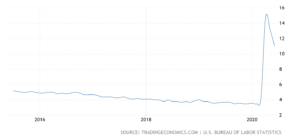If life were closer to normal today, the economy might still be humming along.
Of course, life is not normal and the economy has been affected by events begun anyone’s control. Millions of jobs were lost when businesses were shut down for three months during the pandemic. Rioting and looting during protests following the death of George Floyd also hurt the economy. President Trump’s trade wars likewise dinged economic growth.

The unemployment rate dropped to a 50-year low after tax reform was enacted, but soared during the pandemic.
But the Tax Cuts and Jobs Act (TCJA) that was signed into law in 2017, accompanied by deregulation, has been a success. While it boosted the economy before the pandemic, it’s also helping the economy today. It would be more difficult for the economy to recover from the shutdown if tax rates were at pre-2017 levels and the regulatory burden faced by the private sector had not been reduced.
“The year began with a recovery that belied every negative cliché about the Trump tax cuts and regulatory reform,” Phil Gramm and Mike Solon wrote in The Wall Street Journal. “Tax cuts demagogued as giveaways to the rich were creating higher wages and bonuses for workers and producing the lowest unemployment rates on record for blacks, Hispanics, single women, the disabled and those with criminal records. Wages at the bottom were growing faster than at the top. The once-disappearing middle class was prospering … again.”
The non-partisan Congressional Budget Office reported that the tax cuts had generated enough additional growth to add $7.4 trillion to gross domestic product over the next 10 years, raising average annual per capita income by $2,250. Over the next decade, that increased growth is projected to generate $700 billion more in state and local taxes, and $1.438 trillion in additional federal revenue, offsetting the tax cut’s projected 10-year cost of $1.456 trillion.
Taxes and Inversions
Before the Tax Cuts and Jobs Act was enacted, America was at a competitive disadvantage, as America’s corporate rate of 35% was the highest in the developed world. Tax reform dropped the corporate rate to 21%.
In addition, American businesses with international operations paid taxes twice – first on corporate profits in the country in which they were earned, then again at a rate of 35% when they returned their earnings to the U.S. This resulted in dozens of companies moving their headquarters to other countries, while holding at least $2.5 trillion abroad.
Tax reform created a territorial tax rate (i.e., with taxes paid where profits are accrued) and set a one-time 15.5% tax rate on cash, and 8% on non-cash or illiquid assets being returned to the U.S.
Bloomberg reported in December that more than $1 trillion had been repatriated, increasing tax revenues in spite of the lower tax rate. In addition, research by the University of New Hampshire Scholars’ Repository noted last year that no U.S. companies had moved their headquarters abroad since the Tax Cuts & Jobs Acts had been enacted.
The tax cuts were “a windfall for major American corporations,” according to The New York Times, helping to drive up the profitability of companies in the S&P 500 more than 20% in 2018. Higher profits drove stock prices higher and provided businesses with the capital to expand, hire more employees and increase wages.
Wages, which stagnated after the financial crisis, increased after the passage of tax reform, while the unemployment rate dropped. Before the pandemic, many employers reported that their greatest challenge was hiring qualified employees.
MarketWatch reported in February that, “Real disposable income per household has increased by an average of about $5,000 since the TCJA became law. Labor force participation has increased. The economy has added about 6 million jobs since January of 2017. Unemployment is at a 50-year low.”
Gramm and Solon noted that real median weekly wages have risen six times as much during the past three years than during the eight years of the Obama Administration. Labor-force participation, likewise has risen by 1.1%, while it dropped 4.6% under President Obama.
“In the first three years of the Trump administration, total employment was up 4.7% and real median household income was up $4,384, to an all-time high,” Gramm and Solon wrote. “Who benefited most? The groups Democrats claim to represent: blacks, Hispanics, single women, Native Americans, high-school dropouts, the disabled and those with criminal records. Each of those groups enjoyed the lowest unemployment rates on record. Blacks and Hispanics had the lowest incidence of poverty ever recorded.”
If elected President, Democratic candidate Joe Biden plans to repeal tax reform. He is also proposing additional taxes, such as a carbon tax and a new minimum tax on small businesses. Adding new taxes as America struggles to recover from the pandemic could result in a long, difficult recession.
